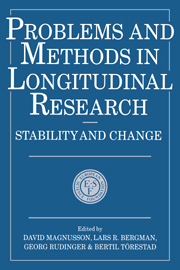Book contents
- Frontmatter
- Contents
- Contributors to this volume
- Foreword
- Preface
- 1 Studying individual development: problems and methods
- 2 Modeling individual and average human growth data from childhood to adulthood
- 3 Intraindividual variability in older adults' depression scores: some implications for developmental theory and longitudinal research
- 4 Now you see it, now you don't – some considerations on multiple regression
- 5 Differential development of health in a life-span perspective
- 6 Assessing change in a cohort-longitudinal study with hierarchical data
- 7 Statistical and conceptual models of ‘turning points’ in developmental processes
- 8 Qualitative analyses of individual differences in intra- individual change: examples from cognitive development
- 9 Application of correspondence analysis to a longitudinal study of cognitive development
- 10 Event-history models in social mobility research
- 11 Behavioral genetic concepts in longitudinal analyses
- 12 Genetic and environmental factors in a developmental perspective
- 13 Structural equation models for studying intellectual development
- 14 Longitudinal studies for discrete data based on latent structure models
- 15 Stability and change in patterns of extrinsic adjustment problems
- Index
6 - Assessing change in a cohort-longitudinal study with hierarchical data
Published online by Cambridge University Press: 27 April 2010
- Frontmatter
- Contents
- Contributors to this volume
- Foreword
- Preface
- 1 Studying individual development: problems and methods
- 2 Modeling individual and average human growth data from childhood to adulthood
- 3 Intraindividual variability in older adults' depression scores: some implications for developmental theory and longitudinal research
- 4 Now you see it, now you don't – some considerations on multiple regression
- 5 Differential development of health in a life-span perspective
- 6 Assessing change in a cohort-longitudinal study with hierarchical data
- 7 Statistical and conceptual models of ‘turning points’ in developmental processes
- 8 Qualitative analyses of individual differences in intra- individual change: examples from cognitive development
- 9 Application of correspondence analysis to a longitudinal study of cognitive development
- 10 Event-history models in social mobility research
- 11 Behavioral genetic concepts in longitudinal analyses
- 12 Genetic and environmental factors in a developmental perspective
- 13 Structural equation models for studying intellectual development
- 14 Longitudinal studies for discrete data based on latent structure models
- 15 Stability and change in patterns of extrinsic adjustment problems
- Index
Summary
The basic research question to be addressed in the present chapter is the following: How do we measure time-related change in a study with a non-experimental design? Or more specifically: How can we document possible effects of an intervention program against bully/victim problems in school when it is not possible to employ an experimental set-up with randomized assignment of observational units to various treatment conditions?
SOME BACKGROUND INFORMATION
Bully/victim problems among children (‘mobbing’) have been an issue of great concern in Scandinavia for almost two decades (Olweus, 1973, 1986, in preparation). There is a bully/victim problem in a class or a school when a student, repeatedly and over time, is exposed to harassment and attacks from one or several other students (Olweus, 1991). In addition, there should be a certain imbalance in the strength relations: the student who is exposed to the negative actions should have difficulty defending himself or herself and be somewhat helpless against those who harass.
In Norway, bully/victim problems were a matter of general interest and concern in the mass media and among teachers and parents for a number of years, but the school authorities did not engage themselves officially with the phenomenon. A few years ago, a marked change took place.
- Type
- Chapter
- Information
- Problems and Methods in Longitudinal ResearchStability and Change, pp. 107 - 132Publisher: Cambridge University PressPrint publication year: 1991
- 39
- Cited by



